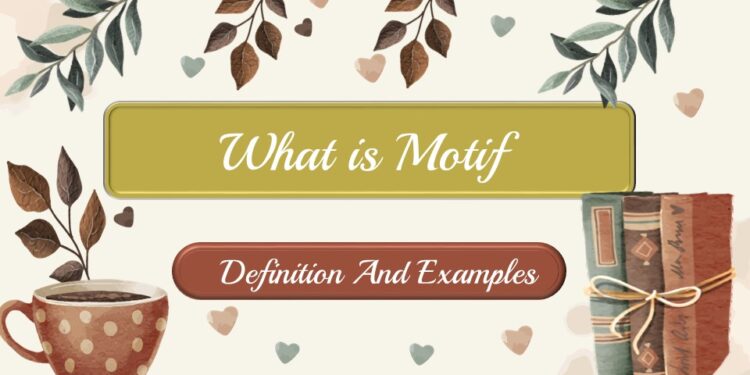What is Motif Definition And Examples
A motif is a recurring thematic element, image, symbol, or idea that appears throughout a literary or artistic work. It serves as a unifying element that contributes to the overall meaning, mood, and structure of the work. Motifs add depth, symbolism, and coherence to the narrative, enhancing the reader’s understanding and appreciation of the piece.
A motif can take various forms, including objects, colors, actions, words, phrases, or even specific themes. It often repeats or recurs in different contexts or situations, allowing the audience to identify its significance and interpret its meaning. What is Motif Definition And Examples Motifs can be subtle and require close attention to notice, or they can be prominent and intentionally emphasized by the author or artist.
Also Read-
- What is Mood Definition And Examples
- What is Metonymy Definition And Examples
- What is Metaphor Definition And Examples
The use of motifs is not limited to literature; they can be found in other art forms such as visual arts, music, and film. What is Motif Definition And Examples In each case, motifs contribute to the artistic work’s overall unity and provide a thread that connects various elements together.
Motifs serve several purposes in literary and artistic works:
- Symbolism: Motifs often carry symbolic meaning, representing broader ideas, themes, or concepts. They can add layers of meaning and evoke emotions beyond the literal interpretation. What is Motif Definition And Examples For example, a recurring motif of water in a novel may symbolize purification, rebirth, or the passage of time.
- Unity and Coherence: Motifs contribute to the overall unity and coherence of a work. They help tie together different elements and create a sense of thematic consistency. What is Motif Definition And Examples By repeating certain images or ideas, motifs create patterns and establish connections, enriching the reader’s understanding of the work as a whole.
- Character Development: Motifs can be used to deepen the characterization of individuals in a story. What is Motif Definition And Examples By associating specific motifs with certain characters, authors can convey their traits, desires, or inner conflicts. For instance, a character repeatedly engaging in acts of kindness may be associated with a motif of flowers, emphasizing their gentle and caring nature.
- Foreshadowing and Suspense: Motifs can be employed as a narrative tool to foreshadow future events or create suspense. What is Motif Definition And Examples By subtly introducing a motif associated with impending danger or a significant turning point, the author can build anticipation and engage the reader’s curiosity.
- Mood and Atmosphere: Motifs can contribute to the creation of a specific mood or atmosphere within a work. What is Motif Definition And Examples The repetition of certain images, colors, or sounds can evoke particular emotions or create a distinct ambiance. For example, a recurring motif of darkness may convey a sense of fear, mystery, or melancholy.
- Cultural and Historical Context: Motifs can reflect the cultural, historical, or social context in which a work is created. What is Motif Definition And Examples They may draw on shared cultural symbols, myths, or archetypes, resonating with the audience’s collective knowledge and experiences. Motifs can thus provide insights into the cultural milieu in which the work was produced.
To better understand the concept of motifs, let’s explore a classic example from literature: F. Scott Fitzgerald’s novel “The Great Gatsby.” One of the prominent motifs in the book is the green light located across the water from Gatsby’s mansion. What is Motif Definition And Examples The green light represents Gatsby’s hopes, dreams, and aspirations, particularly his longing for Daisy Buchanan. It serves as a symbol of the elusive American Dream and the pursuit of wealth and social status. What is Motif Definition And Examples The motif recurs throughout the novel, capturing Gatsby’s yearning and the themes of unattainable dreams and the corrupting influence of materialism.
Examples Of Motif
- “To Kill a Mockingbird” by Harper Lee:
- The mockingbird: This motif represents innocence and the idea of harming those who are innocent and defenseless.
- The oak tree: The oak tree is a recurring motif that symbolizes safety, comfort, and the bond between characters.
- “The Lord of the Rings” by J.R.R. Tolkien:
- The ring: The ring is a central motif in the story, representing power, corruption, and the temptation to misuse it.
- Light and darkness: The motif of light and darkness highlights the ongoing battle between good and evil throughout the narrative.
- “The Great Gatsby” by F. Scott Fitzgerald:
- The green light: The green light across the water from Gatsby’s mansion symbolizes his dreams, aspirations, and unattainable desires.
- The eyes of Doctor T.J. Eckleburg: This recurring motif of a billboard with large, faded eyes represents the loss of moral values and the corrupt state of society.
- “Harry Potter” series by J.K. Rowling:
- The lightning scar: Harry Potter’s lightning-shaped scar is a recurring motif that signifies his connection to Voldemort and the burden of his destiny.
- The phoenix: The motif of the phoenix represents rebirth, resilience, and the cyclical nature of life.
- “Inception” (film) directed by Christopher Nolan:
- Spinning top: The spinning top serves as a motif that represents reality and the characters’ struggle to distinguish between dreams and the real world.
- Maze-like structures: The recurring motif of intricate and labyrinthine structures reflects the complexity and confusion of the dream world.
Conclusion
Motifs play a significant role in literature and other art forms by providing recurring thematic elements, symbols, or images that contribute to the overall meaning, unity, and impact of a work. What is Motif Definition And Examples They enhance the storytelling by adding depth, symbolism, and coherence, allowing the audience to gain deeper insights, interpret underlying themes, and appreciate the artistic richness of the piece.
FAQ.
Q. How can I identify motifs in a literary work?
Ans. Motifs are often recurring elements, symbols, or images that appear throughout the work. Look for patterns, repetitions, or connections between different scenes, characters, or objects. Pay attention to the author’s emphasis on certain details or ideas that stand out and have a consistent presence.
Q. What is the difference between a motif and a theme?
Ans. While both motifs and themes contribute to the overall meaning of a work, they differ in scope and nature. Motifs are specific recurring elements or symbols that enhance the storytelling and provide symbolic depth. Themes, on the other hand, are broader underlying ideas or messages explored in the work.
Q. Can motifs have different interpretations?
Ans. Yes, motifs can have multiple interpretations depending on the context and the reader’s perspective. The symbolism and meaning of a motif may vary, and different readers may draw different conclusions based on their individual understanding and analysis of the work.
Q. Can motifs be unintentional or accidental?
Ans. Sometimes motifs can emerge unintentionally during the creative process. Authors or artists may introduce certain elements without consciously intending them to be motifs. However, once recognized by readers or viewers, these recurring elements can still contribute to the overall meaning and interpretation of the work.
Q. Do motifs have to be explicitly stated or explained by the author?
Ans. No, motifs do not have to be explicitly stated or explained by the author. In fact, motifs often rely on subtle repetition or symbolism, allowing readers or viewers to interpret their meaning and significance. The open-ended nature of motifs allows for personal engagement and varying interpretations.
















